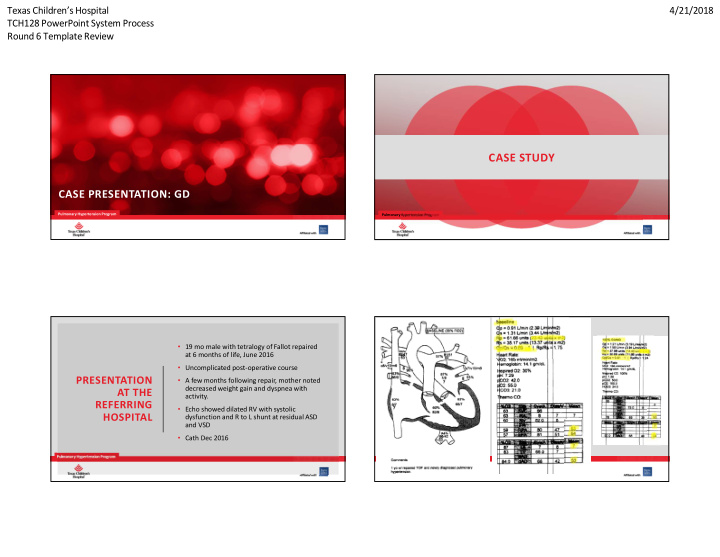



Texas Children’s Hospital 4/21/2018 TCH128 PowerPoint System Process Round 6 Template Review CASE STUDY CASE PRESENTATION: GD Pulmonary Hypertension Program Pulmonary Hypertension Program DEPARTMENT NAME DEPARTMENT NAME • 19 mo male with tetralogy of Fallot repaired at 6 months of life, June 2016 • Uncomplicated post-operative course PRESENTATION • A few months following repair, mother noted decreased weight gain and dyspnea with AT THE activity. REFERRING • Echo showed dilated RV with systolic HOSPITAL dysfunction and R to L shunt at residual ASD and VSD • Cath Dec 2016 Pulmonary Hypertension Program Pulmonary Hypertension Program DEPARTMENT NAME DEPARTMENT NAME
Texas Children’s Hospital 4/21/2018 TCH128 PowerPoint System Process Round 6 Template Review • Remained intubated following cath, receiving inhaled nitric oxide and FiO2 1.0 • CT chest showed changes of pulmonary • Within 6 hours after cath, developed pulmonary edema, not responsive to hypertension, not PVOD diuretics • No centrilobular nodules, no increased septal thickening. • Resolved with discontinuation of iNO • Strong concern for PVOD Pulmonary Hypertension Program Pulmonary Hypertension Program DEPARTMENT NAME DEPARTMENT NAME • The child was stabilized and extubated • Discharged home on steroids, diuretics and oxygen as needed. • Lung biopsy: pathology was read locally and by consulting • Worsening hypoxemia and work of breathing. pathologist as isolated pulmonary arterial hypertensive • Inpatient admission for high flow nasal cannula support. changes, normal venules • PH medications were not started because of poor clinical • Not consistent with PVOD. tolerance. • Transferred to Texas Children’s Hospital for transplant evaluation and pulmonary hypertension management (7/31/17). Pulmonary Hypertension Program Pulmonary Hypertension Program DEPARTMENT NAME DEPARTMENT NAME
Texas Children’s Hospital 4/21/2018 TCH128 PowerPoint System Process Round 6 Template Review • Maintained on high flow nasal cannula of 7 LPM at 25% • Comfortably tachypneic • Review of CT chest: suspicious to medical team for PVOD; biopsy re- • He showed little response to increase in flow. evaluated • At night, supported with positive airway pressure for his CLINICAL • TCH radiology and pathology disagreement with PH team increased work of breathing (initial CPAP 6, changed to BPAP 12/6). • PH medications not started COURSE AT • Goal saturations were 88-95%. • Lung transplant team consulted TEXAS • Steroids from the referring institution were weaned off. • Evaluation was completed and he was approved by the multidisciplinary • Continued on bumetanide with additional doses of CHILDREN’S team for listing (8/10/17) diuretics as needed to maintain saturations and reduce work of breathing. • Insurance approval could not be obtained for transplant listing despite discussions, letters and paperwork Pulmonary Hypertension Program Pulmonary Hypertension Program DEPARTMENT NAME DEPARTMENT NAME • The child acutely desaturated during a bowel movement, requiring bagging and eventually, intubation for worsening acute respiratory failure (9 AM). • Developed pulmonary edema POST-MORTEM ANALYSES • Persistent hypoxemia • iNO, iloprost and oxygen given for rescue 8/30/17 • Decreased cardiac output • Supported with epinephrine drip • Bradycardic event, no return of spontaneous circulation • 7 cycles of CPR with epinephrine, bicarbonate, calcium • Time of death: 10 AM Pulmonary Hypertension Program Pulmonary Hypertension Program DEPARTMENT NAME DEPARTMENT NAME
Texas Children’s Hospital 4/21/2018 TCH128 PowerPoint System Process Round 6 Template Review AUTOPSY Lungs, features consistent with pulmonary veno-occlusive disease: 1. Interlobular septal vein, thickening with intimal sclerosis, variable occlusion, mild-moderate, patchy, bilateral. 2. Interlobular septal broadening and edema, venolymphatic ectasia, severe, diffuse, bilateral. 3. Intra-alveolar hemosiderosis, mild, patchy, bilateral. 4. No evidence of mutations in the EIF2AK4 gene by whole exome sequencing (Baylor Miraca Genetics). B. Secondary pulmonary arteriolar hypertensive changes, moderate-severe, diffuse, bilateral. C. No evidence of parenchymal fibrosis or infection. D. Congestive lymphadenopathy with sinus expansion, hilar and Occluded venule with partial mediastinal, bilateral. recanalization, diagnostic for PVOD Pulmonary Hypertension Program Pulmonary Hypertension Program DEPARTMENT NAME DEPARTMENT NAME • Whole exome sequence negative for mutations (9/14/17) • Heterozygous for missense variants of uncertain clinical significance on PAH mutation panel* • KCNA5 • NOTCH3 COMMENTS/QUESTIONS? * Texas Children’s PAH genetic panel: ACVRL1, BMPR2, CAV1, EIF2AK4, ENG, GDF2, KCNA5, KCNK3, NOTCH1, NOTCH3, SMAD4, SMAD8, TOPBP1 Pulmonary Hypertension Program DEPARTMENT NAME DEPARTMENT NAME
Texas Children’s Hospital 4/21/2018 TCH128 PowerPoint System Process Round 6 Template Review FINAL DIAGNOSIS - PVOD • • Rare form of pulmonary hypertension Similar presentation to PAH but worse prognosis. • 3-12% of those labeled idiopathic PAH • Life threatening pulmonary edema • Estimated 1-2 cases per million may occur following PH therapy • Preferential involvement of the • Heritable PVOD has been described pulmonary venous system • • biallelic mutations of EIF2AK4 Pathologic findings: • No effective treatments except for • obliteration of small pulmonary veins by lung transplantation intimal thickening • patchy capillary proliferation Pulmonary Hypertension Program DEPARTMENT NAME
Recommend
More recommend